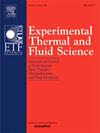超声速隔离器中等离子体射流抑制冲击列车振荡的实验研究
IF 2.8
2区 工程技术
Q2 ENGINEERING, MECHANICAL
Experimental Thermal and Fluid Science
Pub Date : 2025-01-29
DOI:10.1016/j.expthermflusci.2025.111428
引用次数: 0
摘要
在真实的冲压发动机中,燃烧不稳定会导致不稳定的燃烧压力,进而破坏进气隔离器的冲击链,从而带来操作风险。本文分别在2.5马赫自由流条件下进行了恒定背压和增量背压冷流实验,探讨了等离子体射流(PJ)在超声速流动控制中的潜力。随着工作材料压力的增加,PJ的稳定核心区域扩大,从而显示出增强的控制能力。在超声速进口隔振器中,垂直注入的PJ被压缩并产生强大的激波,主导下游流场。PJ诱导的激波与前缘激波相互作用,导致激波列轻微的上游运动。等离子体作动器的实现抑制了自激振荡。空间FFT分析表明,前缘激波的振荡频率和振荡范围均有所减小,对范围的抑制率为37.44%。PJ促进了剪切层附近的动量交换,重新分配了振荡能量。优势激波将振荡能量传播到下壁,从而使能量分布均衡。进一步的强迫运动特性研究表明,在增量背压下,PJ有效地降低了至少43.63%的低频振荡能量,并且在激波序列附近获得了更好的控制效率。PJ产生的高频环境和PJ产生的激波被认为是抑制激波序列自激和强迫激振荡的重要因素。本文章由计算机程序翻译,如有差异,请以英文原文为准。
Experimental investigation of shock train oscillation suppression by a plasma jet in a supersonic isolator
In a real ramjet engine, combustion instability gives rise to an unstable combustion pressure, which in turn disrupts the shock train in the inlet isolator, thereby introducing operational risks. This paper investigates the potential of the plasma jet (PJ) in supersonic flow control through a series of cold flow tests conducted at constant and incremental back pressure at Mach 2.5 freestream flow, respectively. As the pressure of the working material increases, the stable core region of the PJ expands, thereby demonstrating enhanced control capabilities. In the supersonic inlet isolator, the vertically injected PJ is compressed and induces a strong shock wave that dominates the downstream flow field. The shock wave induced by the PJ interacts with the leading-edge shock wave and results in a slight upstream movement of the shock train. The self-excited oscillation is suppressed with the implementation of the plasma actuator. The spatial FFT analysis indicates a reduction in both the oscillation frequency and the oscillation range of the leading-edge shock wave, with a suppression rate of 37.44% for the range. The PJ facilitates the momentum exchange near the shear layer and redistributes the oscillation energy. The dominant shock wave propagates the oscillation energy to the lower wall, thereby equalizing the energy distribution. Further studies on forced moving features demonstrate that the PJ effectively reduces low-frequency oscillation energy by at least 43.63% under incremental back pressure and achieves better control efficiency closer to the shock train. The high-frequency environment generated by the PJ and the shock wave induced by the PJ are considered the important factors in suppressing both self-excited and forced-excited oscillation of the shock train.
求助全文
通过发布文献求助,成功后即可免费获取论文全文。
去求助
来源期刊

Experimental Thermal and Fluid Science
工程技术-工程:机械
CiteScore
6.70
自引率
3.10%
发文量
159
审稿时长
34 days
期刊介绍:
Experimental Thermal and Fluid Science provides a forum for research emphasizing experimental work that enhances fundamental understanding of heat transfer, thermodynamics, and fluid mechanics. In addition to the principal areas of research, the journal covers research results in related fields, including combined heat and mass transfer, flows with phase transition, micro- and nano-scale systems, multiphase flow, combustion, radiative transfer, porous media, cryogenics, turbulence, and novel experimental techniques.
 求助内容:
求助内容: 应助结果提醒方式:
应助结果提醒方式:


